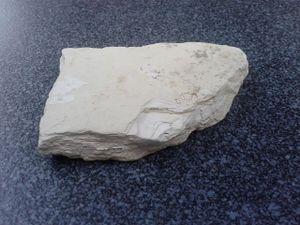Diatomaceous earth
 |
This article is a stub. Please help Sciencemadness Wiki by expanding it, adding pictures, and improving existing text.
|
Diatomaceous earth (D.E.) more commonly known as diatomite, kieselgur/kieselguhr or celite, is a naturally occurring, soft and frangible siliceous sedimentary rock. Diatomaceous earth mainly consists of fossilized remains of diatoms, a type of hard-shelled algae, with other impurities such as metals (usually iron and calcium) and minute traces of organic matter.
Contents
Properties
Chemical
Diatomaceous earth consists mostly of silicon dioxide and resists corrosion by acids.
Heating diatomite between 800-1000 °C in a kiln will cause it to turn orange-red.
Physical
Diatomite is a white-ish light solid, with an abrasive feel, and highly porous. It also displays cleavage. Kieselgur is very light, with a density of 2.3 g/cm3 (bulk) and 0.256 g/cm3 (powder).
Availability
Diatomaceous earth is available in many garden shops as insect killer. It can also be purchased online.
Projects
- Water filtration
- Adsorbing agent
- Thermal insulator
- Make dynamite
- Catalyst support
Handling
Safety
Powdered diatomaceous earth is irritant to lungs and long-term exposure may cause silicosis.
Storage
Diatomite should be stored in closed bottles.
Disposal
No special disposal is required, though it's best to avoid scattering it in air.
